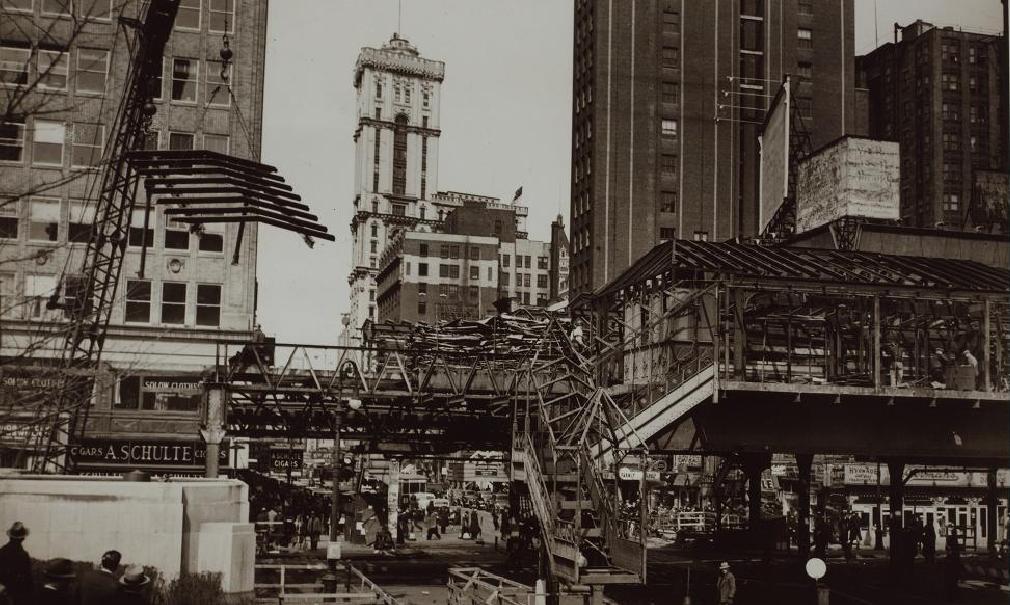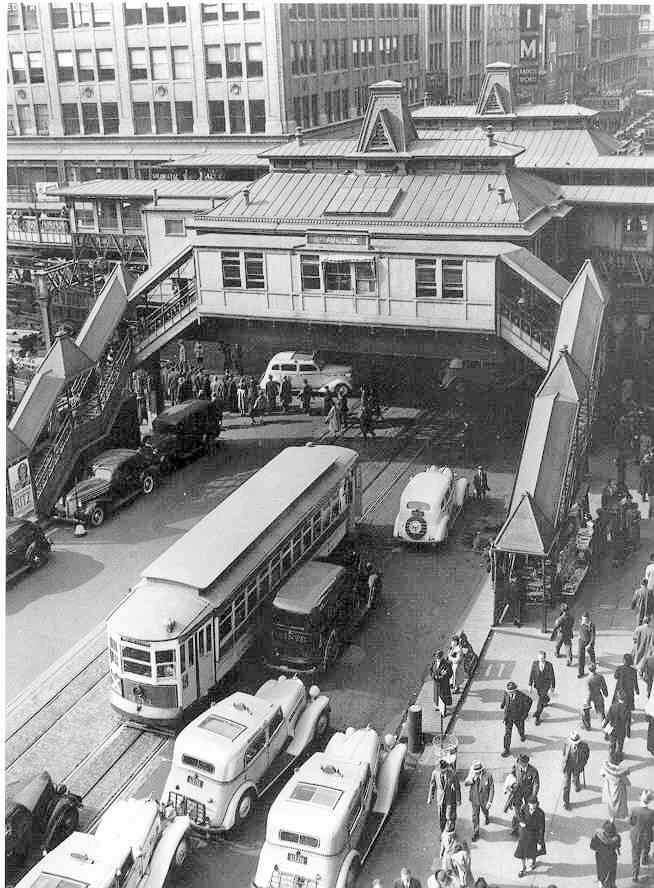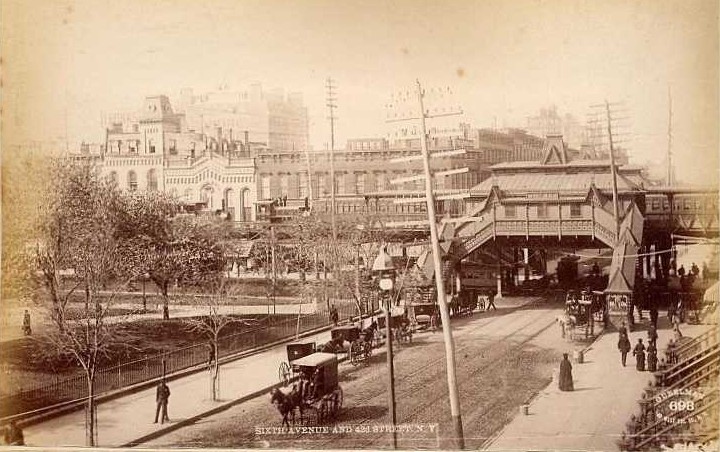The Sixth Avenue El route, cross-streets & stations
|
See the track map and links to the location images.
Going North from Battery Place, at the junction with the Ninth Ave Line the two track structure over Greenwich St spreads out from a level double turnout to a four track structure with the 6th Ave Line on the right. From the South, the Sixth and Ninth Ave lines part at the junction of Trinity Place and Greenwich St at Morris St. Trinity Place is a few feet higher in elevation than Greenwich St. The two tracks of the 6th Ave half of the structure on Greenwich St ramped up from the actual rail junction at the north end of the Battery Place Station and turned to the right at Morris St onto Trinity Place. The original plans show the line turning east (from the north) onto Morris St to go over to Broadway at Bowling Green and proceeded south from there to South Ferry. The route was changed in 1881 to join the Sixth with the Ninth Ave lines as described above.
Going North on Trinity Place (originally the lower portion of Church St) the line crossed the following streets; The Trinity Place structure had 3 tracks north to the Cortlandt St station.
Morris
Edgar � Steam engines were serviced here in that era
Exchange Alley
Rector St Station - the southern terminal (3 tracks).
Thames
Cedar
Liberty � north from here the street name reverts to Church Street
Cortlandt St Station - a passageway connected to the 9th Ave El Station,
the structure narrowed to 2 tracks north of the station.
Dey
Fulton
Vesey
Barclay (9th Ave El Station)
Park Place Station
Murray St - the two track structure curved 1 block west here and then turned north onto West Broadway.
The following streets cross or end at West Broadway
Warren St (9th Ave El Station)
Chambers St Station - the structure expands to 4 tracks north of the station
Reade
Duane
Thomas
Worth
Leonard; Varick St ends at Leonard St
Franklin St Station - the structure narrows to 2 tracks north of the station
White
North Moore ends at West Bway
Walker
Beach St & Ericsson Place end at West Bway & St John�s Lane
Lispenard
York ends at West Bway
Canal
Grand St Station
Broome
Watts ends at West Bway
Spring
Prince
Houston
Bleeker St Station
West 3rd St - The line turns West for 4 blocks to Sixth Ave. Carmine ends at West 3rd and the following north-south streets intersect West 3rd St;
Thompson
Sullivan
MacDougal
Sixth Ave - The line turns north from West 3rd St and crosses the following streets;
West 4th St - Cornelia ends at West 4th
West Washington Pl
Waverly Pl - (Washington Sq Park South is North of W 3rd St.)
8th St Station - The Jefferson Market bldg
Christopher St and Greenwich Ave end at 6th Ave between 8th & 9th Streets.
On Sixth Ave, the line crossed the numbered streets; 9th, 10th, etc, until the end of track at 59th St or Central Park South.
Stations on Sixth Ave (going north) are at 8th, 14th, 23rd, 28th, 33rd, 38th, 42nd, 50th and 58th St.
Broadway crosses 6th Ave at 34th St and is known as Herald Sq.
The station at 33rd St is also known as Greeley Sq
At 53rd St the line turned east to join the 9th Ave El.
The 53rd St connector crossed 7th Ave and there was a station was at 8th Ave.
At Ninth Ave, the line turns north to join the 9th Ave El.
The line as originally built in 1878 went to a terminal at 58th St and the junction at 53rd St to the Ninth Ave Line existed until 1924 after which time only the curve onto 53rd St remained until the end of service.
|
A description of the line and landmarks along the line.
|
From the bent south of the junction at 53rd St, the structure on the length of Sixth Ave was unique in that it was an outside braced or thru-trussed two-track structure of a European design. This design had shallow longitudel girders supporting the rails with additional cross girders at the joint of each truss section as opposed to long deep track deck plate or open fabricated supporting girders from bent to bent on that characterized the other El structures. All stations on the Sixth Ave line were outboard platforms and had a distinctive small spire or cupola at the center of the distinctive station house.
Following the line south on Sixth Ave from the end of track at 59th St, the 58th St terminal stub station was a three-track structure with two outboard station houses situated at the center of the platforms. Three large block bumpers identified the end of track. An outboard switch tower straddled the west side of 57th St to control the cross-overs at the south end of the station. The three-track structure continued south until just north of the junction at 53rd St, where the three tracks merged into two and the 53rd St connector structure from the west at Ninth Ave joined the Sixth Ave structure at a level double turnout. The junction at 53rd St was controlled by an outboard switch tower at the North East corner of 53rd St & Sixth Ave. The 58th St stub terminal was removed in 1924 leaving only the curve at 53rd St with barley any evidence that a junction once exited there. Sixth Ave Line operations were merged into Ninth Ave Line operations early in the history of Sixth Ave Line making the 58th St terminal into a shuttle operation from 50th St with only rush hour trains running the length of the line beginning and terminating at 58th St. The center track was used as a run-around or escape track during steam operations and served as a lay-up track after electrification in 1903.
The first station south of 53rd St was the 50th St Station. This station gained fame in the final years of the line as Rockefeller Center and the Radio City Music Hall were built at 50th St & 6th Ave. Many archival photographs document the transformation of the residential area into a commercial area with its skyscraper structures. The 50th St station also served as a turn-back for the 58th St shuttle train. A turn-back cross-over existed at the south end of the 50th St platforms at 49th St to facilitate that turn-back operation.
The next station south of 50th St was at 42nd St. 42nd St has always been a major cross town street. In the 19c, the Crystal Palace exhibition hall occupied the space where the NY Public Library main building is located. A small reservoir occupied the space adjacent to the Crystal Palace where Bryant Park is now located. Construction of the line began here in 1876.
To be continued...
|
The 6th Avenue El Important Dates
|
June 17, 1872 - The Gilbert Elevated Railway Company was chartered. Dr. Rufus H. Gilbert. Gilbert, a former medical practitioner, became interested in transportation matters, invented and patented a compressed air method of propulsion through elevated tubes. He had envisioned a rapid transit system based upon this method. The Gilbert Company ran into financial troubles and legal complications. The company was renamed to the Metropolitan Elevated Railway Company and would be franchised to construct a steam operated railway above 6th Avenue.
April 19, 1876 - Construction of the Metropolitan Elevated Railway line began at the northeast corner of 6th Ave and 42nd St. The two-track line on Sixth Ave was built using a through-girder type of construction, which was different from deck girder work employed on the other NY elevated lines. It appeared to be similar to European elevated railway structures.
June 5, 1878 - The Metropolitan Elevated Railway or what would be known as the 6th Ave El began operations from stations Rector St, Cortlandt St, and Park Place, all on Church Street; Chambers St, Franklin St, Grand St, Bleecker St, all on West Broadway; 8th, 14th, 23rd, 28th, 33rd, 42nd, 50th and 58th Streets, all on Sixth Avenue. Where the line was to go from 58th St is only conjecture. Probably it would have connected to the 9th Ave line at 59th St or may have turned east to connect up with the 3rd Ave Line. The locomotives and rolling stock were raised to the structure by means of a temporary incline on Church Street, behind Trinity Church (near Rector Street).
In the original plans, the line would have turned east from Church St onto Morris St to go over to Broadway at Bowling Green and proceeded south from there to South Ferry. However, the route was changed to join the Sixth with the Ninth Ave line as described in 1881.
The locomotives had a 2-4-2 wheel arrangement, weighed 15 tons and were painted a pea green color. The passenger cars were painted a light green with pea green and gold trim and had wheels of highly compressed paper and steel rims. The interiors contained oak and mahogany woods, sported Axminster carpeting and introduced 3 chandeliers of kerosene lighting. The original fare was 10 cents to ride in one of the finely appointed cars of that era.
A repair and storage facility in 1881 was notably absent from the Sixth Ave line. There was a four track segment on the West Broadway and a three track segment on Church St structure between Cortlandt St and, which were initially steam engine service and storage tracks.
July 8, 1878 - The 6th Ave line was connected to 9th Ave line by a 2-track connecting structure from a westbound junction at 53rd St to a northbound junction at 9th Ave.
Jan 9, 1879 - The Sixth Avenue line began a temporary shuttle that operated from 50th St Station to the 8th Ave Station on the 53rd St connecting structure. The intermediate station at Eighth Ave was one of only two stations on the Manhattan El system on a north-south Avenue. The other was at Second Ave on the 34th St Branch. The line expanded to 3 tracks at 8th Ave to make the that station a local stop with a center express track. However, that track originally served as a turn-back for the steam locomotives.
Feb 25, 1879 - Through service to 53rd St and 8th Ave began.
The 58th St station became a stub shuttle station with through service to and from downtown in rush hours and a single car shuttle to 50th St the remainder of the time. The 58th St station was a three track station structure. The center track was used initially for steam engine turn-backs and after electrification it was a lay-up track for the through trains that eliminated from there.
Nov 1, 1881 - The 6th Ave line operated to South Ferry and all night service was inaugurated on the line. As originally planned, the Sixth Ave line would have turned east onto Morris St to go over to Broadway at Bowling Green and proceeded south from there to South Ferry. However, the two track Ninth Ave structure over Greenwich St was modified to a four track structure to join the Sixth Ave line, which ramps down on two of the tracks from the higher elevation of Trinity Place
Jan 1, 1883 - The night trains were discontinued for economy reasons. After many complaints, passengers were permitted to ride the employee trains until
Jan 31, 1883, when half-hourly night service was reinstated and made permanent.
Mar 27, 1897 - Pinstch gas lighting fixtures were introduced on the 6th Ave line. 400 passenger cars were equipped with four gas jet lamps in each car, nine feet apart and at 40 candlepower each. The gas was manufactured at the 155th St yards, and stored in 7� tanks under each car.
Oct 1, 1902 - Electric operation began from Rector St to 58th St.
Nov 2, 1902 - Electric operation was extended to 155th St.
April 4, 1903 - The last steam locomotive ran in revenue service on the 6th Ave line. A couple of steam locomotives were retained and used for work train service for several years on the Els.
Jan 31, 1914 - The 38th St station opened. One would have to examine NY City history to determine the reason for putting a station at this location at this time, the WWI Era.
April 25, 1923 - The Manhattan Railway Company introduced the "Goldenrod" paint scheme for its cars and stations. The first train operated on 6th Ave line. The 38th St station was the first to be painted bright orange with a black roof and the words "Ride on the Open Air Elevated" on the sides.
June 16, 1924 - The 58th St (the original northern terminal) station at Central Park South was closed. Demolition began on August 11.
Dec 4, 1938 - The Sixth Ave Elevated Line ended operations. The El was replaced by the IND Subway line being constructed beneath the street. Due to the difficulties encountered in attempting to keep the Fulton Street Elevated line in Brooklyn in operation during construction of the IND subway line beneath that street, it was determined that the 6th Ave Elevated structure had to be removed to expedite this subway construction. According to some reports, the 6th Ave El structure was suffering from metal fatigue. A sag in the structure required the third rails to be lowered or heightened depending on whether the third rail was on the inboard or outboard side of the track.
After 60 years of operation, the first 25 were under steam operation, one wonders if the structure had been designed to withstand the large volume of traffic that operated on it. It was built and operated as a very busy two-track mainline railway and it showed its age early in its useful life. It was never strengthened or enhanced like the other lines when the center third track was installed on them (1915-16). The IND 8th Ave Subway was built to replace the the 9th Ave El. However, the 6th Ave line was removed first in 1939. For the next year or so, the demolition of the line at the major intersections on Sixth Ave was well documented. For a couple more years, the stub connections at 53rd St and at Morris St identified the former El route. The 6th Ave Subway succeeded the 6th Ave El with its similar connector at 57th St from 8th Ave to turn south on 6th Ave. The flying junctions of the IND Subway line at 57th St are buried deep under the street out of public view. It is interesting to note that at the south end of 6th Ave, the IND 8th Ave Subway construction in 1924, caused Sixth Ave to be extended further south to Church St which eliminated the El route curves on to West 3rd St to West Broadway and Murray St to Church St.

During 1939 this was the scene along Sixth Ave as the El was torn down. The iron and steel was sold to Japan.
The steel was returned on December 7, 1941 and throughout the war in the Pacific.
|
|
|
Powered by Yahoo! Web Hosting
Copyright ©
2007
Yahoo! Inc. All rights reserved.
|
|


